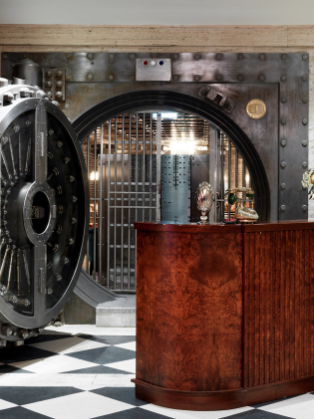Though it has only been around for about a year, the Ned is already the heart of the City. Okay, the prestigious building itself may have been around for a wee bit longer – say, a Century – but ever since it’s housing one of the City’s most talked about hotels it has become even more of a centrepiece. The prestigious grade 1 building (meaning that it’s listed with exceptional interest) is now as beautiful on the inside as it is on the outside, and we just can’t stop thinking about spending the night in one of those dreamy rooms.
We’ve already written a full guide to the hotel’s range of restaurants and bars here, but the building’s history deserves attention too. Let’s take a look.

Sir Edwin Lutyens
The iconic estate was designed by Sir Edwin Lutyens in the early 1920’s and originally built to house the Midland Bank headquarters. Lutyens is particularly known for playing a key role in the development of New Delhi – so much so even, that the Indian city is often referred to as Lutyens’ Delhi. His architectural style is known for its adaptability, clearly visible in the way in which he combined classical architecture with Indian influences in his iconic New Delhi work.
For the Midland Bank, Lutyens designed exterior elevations, the ground floor banking hall, basement safe deposit area, directors’ and boardroom floors and all staircases. Interestingly, he designed the building to look its best from the side, instead of frontally. While colleagues Gotch and Saunders worked on the building’s remaining areas (predominantly its interior), Lutyens himself returned for the extension in 1935.

The heart of the financial centre
For the best part of the 20th Century, the Midland Bank was one of the UK’s largest banks, rightly deserving to be housed in one of the City’s most prominent buildings. Including a theatre as well as an extraordinary walk-in vault that was even featured in James Bond film Goldfinger, the building perfectly reflected the bank’s prestigious position. It was taken over by HSBC in 1992, however, leaving the building to be tenantless for almost a decade. That is, until Nick Jones, founder of Soho House & Co, viewed the building in 2012 and fell in love.
In collaboration with New York hotel developer Sydell Group, Jones took on the challenge of converting the gigantic bank into a luxury (six star!) hotel. Although most of its original interior was torn out during this process, several of its typical bank features have been retained. The former banking hall, for example, now functions as the reception area in which 30’s art deco features are still evident. Paying homage to the building’s creator, Lutyens granddaughter was asked to replicate the architect’s clock and supply suitable light fittings.

Alongside the many preserved historical elements you’ll find in the Ned, the hotel’s overall look exudes modernity and cosiness. Its luxurious Parisian feeling invites to spending long nights at the bar sipping an old-fashioned or martini, and the bedrooms, well … just have a little look here. So next time you pass Poultry Street in the City, make sure to have at least a little peek inside this gorgeous hotel: can you spot the history?
 Back to Blog
Back to Blog


